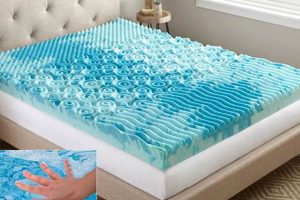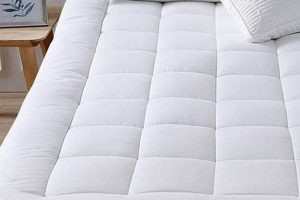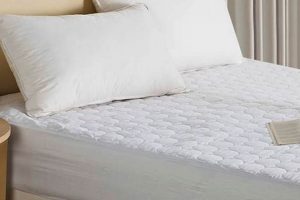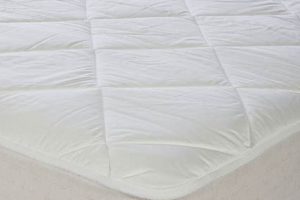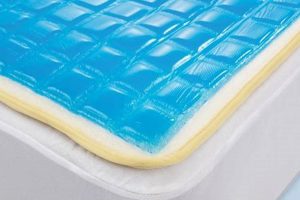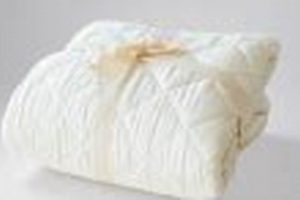Maintaining the cleanliness of electric bedding is crucial for both hygiene and longevity. This task requires careful adherence to manufacturer guidelines to avoid damage to the internal wiring and heating elements. The method typically involves detaching any control units and spot cleaning minor stains before proceeding with a more comprehensive cleaning process.
Regular cleaning of heated mattress covers not only removes allergens, dust mites, and body oils, contributing to a healthier sleep environment, but also helps to maintain the functionality of the warming system. Neglecting this maintenance can lead to uneven heating, reduced efficiency, and potentially shorten the lifespan of the product. Historically, cleaning instructions have evolved from hand-washing only to incorporating gentle machine-washing cycles, reflecting advancements in bedding technology and cleaning agents.
The following sections detail the proper steps for preparing the electric bedding for cleaning, executing the wash cyclewhether by hand or machineand ensuring thorough drying to prevent damage and ensure safe operation. Specific considerations for different types of soiling and troubleshooting common problems will also be addressed.
Cleaning Guidance for Electric Bedding
The following guidelines offer specific recommendations to ensure the safe and effective cleaning of electric bedding while minimizing the risk of damage.
Tip 1: Disconnect Prior to Cleaning: Ensure the power cord is fully detached from the electric bedding and the wall outlet before commencing any cleaning procedure. This is a critical safety measure to prevent electrical shock or short circuits.
Tip 2: Consult the Manufacturer’s Instructions: Locate and carefully review the care label attached to the bedding or the accompanying instruction manual. These documents provide precise cleaning recommendations tailored to the specific model and materials.
Tip 3: Spot Clean as Needed: Address minor stains or spills promptly using a damp cloth and mild detergent. Avoid excessive rubbing or soaking, which could damage the internal wiring.
Tip 4: Use a Gentle Detergent: When machine-washing is permitted, select a mild, pH-neutral detergent formulated for delicate fabrics. Harsh chemicals or bleach can degrade the fabric and potentially compromise the heating elements.
Tip 5: Employ a Gentle Wash Cycle: If machine-washing, opt for the gentle or delicate cycle with cold or lukewarm water. Avoid high spin speeds, which can stress the wiring and cause tangling.
Tip 6: Air Dry Thoroughly: The preferred drying method is air drying. Lay the electric bedding flat on a clean, dry surface or hang it on a clothesline away from direct sunlight. Ensure it is completely dry before reconnecting the power cord.
Tip 7: Avoid Dry Cleaning and Ironing: Dry cleaning solvents and the high heat of an iron can irreparably damage the wiring and heating elements. Refrain from these methods.
Adhering to these cleaning guidelines will not only maintain the cleanliness and hygiene of electric bedding but also prolong its lifespan and ensure safe operation.
The subsequent sections will delve into troubleshooting common issues and provide supplementary information to address specific concerns.
1. Disconnect power supply
The initial step in cleaning electric bedding is disconnecting the power supply. This action is not merely a suggestion but a mandatory safety precaution. Electric bedding contains integrated wiring and heating elements that pose a significant electrical shock hazard if exposed to water or cleaning solutions while connected to a power source. The act of disconnecting severs the electrical circuit, eliminating the risk of electrocution during the washing process. Real-life incidents have underscored the severity of failing to disconnect, resulting in injury and equipment damage.
The consequence of neglecting this step extends beyond immediate safety. Residual electrical current can also damage the internal components of the bedding during washing, rendering it non-functional. Water intrusion into the control unit, even after cleaning, can lead to corrosion and short circuits when the power is subsequently restored. Proper disconnection procedures are often detailed within the manufacturer’s guidelines, emphasizing the importance of this preliminary step in the cleaning protocol.
In summary, disconnecting the power supply before cleaning electric bedding is a critical safety measure and a prerequisite for maintaining the integrity of the product. This action prevents electrical hazards, minimizes the risk of damage to the internal components, and ensures the longevity and safe operation of the bedding after the cleaning process is complete. Adherence to this protocol is paramount for responsible care.
2. Check manufacturer guidelines
The directive to check manufacturer guidelines when addressing electric bedding maintenance stems from the inherent variability in construction and materials across different brands and models. These guidelines are not generic recommendations; they are specific instructions tailored to the unique design and composition of each individual product. Failure to adhere to these guidelines can lead to irreversible damage, rendering the warming function inoperable or, in severe cases, creating a safety hazard. Real-life examples include instances where machine washing, permissible for some models, has destroyed the heating elements of others due to the lack of a preliminary check of the guidelines. The practical significance lies in the prevention of costly repairs or replacements and the assurance of continued safe operation.
Furthermore, cleaning instructions often detail the specific type of detergent that is compatible with the fabric and wiring. The use of harsh chemicals, such as bleach or solvents, can corrode the internal components or degrade the fabric, leading to premature failure. Some electric bedding may have specific temperature limitations for washing and drying, which, if exceeded, can cause shrinkage, warping, or damage to the electronic components. By carefully consulting and following the manufacturer’s instructions, the user ensures that the chosen cleaning method aligns with the material properties and construction of the bedding.
In conclusion, prioritizing the review of manufacturer guidelines is a non-negotiable aspect of proper electric bedding care. This step mitigates the risks associated with inappropriate cleaning methods and contributes to the extended lifespan and sustained performance of the product. Ignoring these guidelines not only voids warranties but also compromises user safety and product functionality.
3. Gentle detergent usage
The imperative for gentle detergent usage in the context of electric bedding maintenance stems from the delicate nature of the internal wiring and fabric composition. Electric bedding incorporates fine wires woven into the fabric to provide heat. Harsh detergents, containing strong chemicals like bleach or enzymes, can corrode these wires over time, leading to localized heating failures or complete cessation of the warming function. The fabric itself, often a blend of synthetics and natural fibers, is susceptible to degradation from harsh chemicals, resulting in shrinkage, fading, or weakening of the fibers. Real-world examples abound where improper detergent selection has led to the premature failure of electric blankets and heated mattress covers, requiring costly replacements.
The significance of gentle detergent usage extends beyond merely preserving the structural integrity of the bedding. Residue from harsh detergents can remain embedded within the fabric even after rinsing, causing skin irritation or allergic reactions, especially for individuals with sensitive skin. Gentle detergents, formulated without harsh chemicals and irritants, are designed to rinse cleanly, minimizing the risk of skin sensitivities. Furthermore, selecting pH-neutral detergents is crucial to prevent alteration of the fabric’s natural pH balance, which can lead to discoloration or accelerated wear. In practical applications, opting for detergents specifically formulated for delicate fabrics or baby clothing often proves to be a suitable choice for electric bedding.
In conclusion, the selection of gentle detergents is a critical component of a proper electric bedding cleaning protocol. This practice directly mitigates the risk of damage to the internal wiring and fabric, prolongs the lifespan of the product, and minimizes the potential for skin irritation. The deliberate choice of mild, pH-neutral detergents represents a tangible investment in both the longevity and the safety of the bedding.
4. Thorough air drying
Thorough air drying is a critical step in the process of electric bedding maintenance, particularly after washing. This process directly influences both the safety and the functionality of the item and must be conducted with diligence.
- Prevention of Electrical Hazards
Residual moisture within the electric bedding’s wiring and heating elements poses a significant electrical hazard. The presence of water can lead to short circuits, electrical shocks, or even fire when the power supply is reconnected. Thorough air drying ensures that all components are completely dry, mitigating this risk. For instance, if moisture remains trapped within the control unit connector, it can cause corrosion and subsequent malfunction upon power restoration.
- Preservation of Heating Element Integrity
The heating elements embedded within electric bedding are often composed of delicate wires. Trapped moisture can accelerate corrosion, leading to the breakdown of these wires and uneven heating, or complete failure of the warming function. Thorough air drying inhibits the corrosion process, thereby preserving the integrity and extending the lifespan of the heating elements. One example is internal wire corrosion due to dampness causing inconsistent heat distribution across the mattress pad.
- Avoidance of Mold and Mildew Growth
Damp bedding provides a conducive environment for the growth of mold and mildew, which can cause unpleasant odors and pose health risks, particularly for individuals with allergies or respiratory sensitivities. Thorough air drying eliminates this moisture, preventing the growth of these microorganisms. If the pad is folded and stored while damp, mold can quickly spread, necessitating disposal of the item.
- Maintenance of Fabric Integrity
The fabric of electric bedding, often a blend of natural and synthetic fibers, can be susceptible to shrinkage or damage if exposed to high heat, as in a clothes dryer. Air drying avoids this risk, preserving the shape and texture of the fabric. Additionally, residual moisture can lead to the weakening of the fabric fibers over time. Properly air drying the fabric will significantly increase longevity.
In summary, thorough air drying is an indispensable component of electric bedding maintenance. This practice not only safeguards against electrical hazards and prevents the growth of mold and mildew but also ensures the long-term functionality and preservation of the bedding. Failing to adequately air dry electric bedding after washing can negate the benefits of the cleaning process and result in costly repairs or replacements.
5. Avoid harsh chemicals
The directive to avoid harsh chemicals when attending to electric bedding care constitutes a primary precaution in preserving the item’s functionality and safety. The composition of these textiles, which integrates wiring and heating elements within fabric, renders them particularly susceptible to damage from aggressive chemical agents.
- Wire Corrosion and Degradation
Harsh chemicals, such as bleach and strong detergents, can corrode the delicate wiring embedded within the bedding. This corrosion weakens the wires, leading to uneven heating, localized failures, or complete cessation of the warming function. The prolonged exposure to these agents can also degrade the wire insulation, increasing the risk of electrical shorts and potential fire hazards. An example is the copper wire degrading with chlorine bleach, breaking it over time and stopping heat function.
- Fabric Damage and Deterioration
The fabrics used in electric bedding, frequently blends of synthetic and natural fibers, are vulnerable to damage from harsh chemicals. These substances can cause discoloration, weakening of the fibers, and shrinkage. Residues from these chemicals may also remain trapped within the fabric after washing, leading to skin irritation or allergic reactions. Detergents high in alkaline substances are known to do this.
- Compromised Flame Retardancy
Many electric bedding products are treated with flame-retardant chemicals to enhance safety. Harsh cleaning agents can strip away or neutralize these flame retardants, compromising the bedding’s ability to resist ignition. The consequence is an elevated risk of fire in the event of a malfunction or external heat source. The use of phosphates, a common water softener in some detergents, can accelerate flame retardant breakdown.
- Residue Buildup and Performance Reduction
Harsh chemicals may leave behind residues within the fabric that interfere with the bedding’s ability to breathe and regulate temperature effectively. This residue buildup can trap moisture, promoting the growth of mold and mildew. Moreover, the residue can impede the transfer of heat, reducing the overall performance and efficiency of the warming function. Quaternary ammonium compounds are known to build up on fabrics after multiple washes.
In light of these potential adverse effects, adhering to a gentle cleaning protocol becomes essential for maintaining electric bedding.
Utilizing mild, pH-neutral detergents, specifically formulated for delicate fabrics, mitigates the risk of damage to the wiring, fabric, and flame-retardant properties. Spot cleaning and avoiding aggressive washing techniques further safeguard the item’s integrity, ensuring its longevity and safe operation. By adopting these precautions, the effective care of electric bedding is enhanced.
Frequently Asked Questions About Electric Bedding Maintenance
This section addresses prevalent inquiries regarding the proper cleaning and care of electric bedding, offering evidence-based guidance to ensure both longevity and safety.
Question 1: Is machine washing electric bedding permissible?
The permissibility of machine washing depends on the manufacturer’s specifications. The care label or owner’s manual provides the definitive answer. Some models are designed to withstand gentle machine washing, while others require hand washing only.
Question 2: What water temperature is recommended for washing electric bedding?
Cold or lukewarm water is generally recommended. High temperatures can damage the wiring and shrink the fabric. Consult the manufacturer’s instructions for precise temperature guidelines.
Question 3: Can electric bedding be placed in a dryer?
Air drying is strongly advised. High heat from a dryer can damage the heating elements and compromise the fabric. If dryer use is permitted, utilize the lowest heat setting for a limited time.
Question 4: How frequently should electric bedding be cleaned?
Cleaning frequency depends on usage and personal preferences. A general guideline is to wash the bedding 1-2 times per year, or more frequently if heavily soiled. Regular spot cleaning can help maintain cleanliness between washes.
Question 5: What type of detergent is best for washing electric bedding?
A mild, pH-neutral detergent specifically formulated for delicate fabrics is recommended. Harsh detergents containing bleach or enzymes can damage the wiring and fabric.
Question 6: How should electric bedding be stored when not in use?
Ensure the bedding is completely dry before storing. Fold it loosely and store it in a cool, dry place away from direct sunlight. Avoid placing heavy objects on top of the folded bedding, as this can damage the wiring.
These FAQs offer a foundation for proper electric bedding care. Adherence to these guidelines and the manufacturer’s instructions will contribute to maintaining a safe and comfortable sleep environment.
The subsequent section will address troubleshooting common problems and offer additional insights for enhanced maintenance practices.
Conclusion
The preceding discussion has delineated the critical steps and considerations involved in how to wash a heated mattress pad safely and effectively. From disconnecting the power supply and consulting manufacturer guidelines to employing gentle cleaning agents and ensuring thorough air drying, adherence to these protocols is paramount. The avoidance of harsh chemicals and the understanding of appropriate water temperatures are equally essential for preserving both the functionality and longevity of the electric bedding.
The consistent application of these guidelines ensures a hygienic and safe sleep environment. By prioritizing meticulous care, users can maximize the lifespan of their electric bedding, preventing costly repairs or replacements while mitigating potential electrical hazards. The informed approach outlined herein represents a fundamental commitment to responsible maintenance and user safety.


